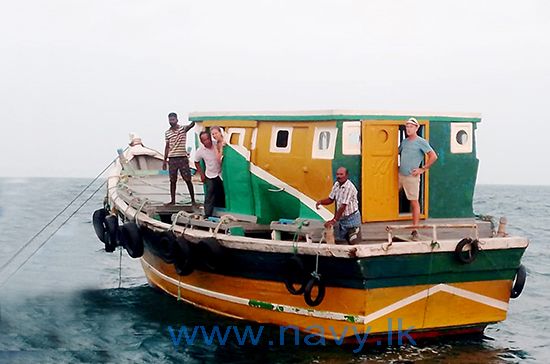News
Navy assists stranded trawler adrift at sea

The Sri Lanka Navy assisted to bring a stranded trawler with a foreign tourist couple back to shore safely, on the night of 09 Feb 25. The trawler had been adrift at sea between Delft Island and Kurikadduwan due to an operational failure, without fuel.
The trawler, with a couple of tourists who had visited Delft Island, was en route from Delft to Kurikadduwan Jetty in the evening of 09 Feb, when it came across the failure and began drifting at sea. The distress was noticed by SLNS Wasabha stationed on Delft Island.
Upon further inspection by the Inshore Patrol Craft P 239 belonging to SLNS Wasabha, it was confirmed that the trawler was adrift without fuel. The Navy promptly provided the necessary assistance and safely brought the trawler, along with the tourists, to Kurikadduwan Jetty.
News
Pope Leo appeals for no more war in first Sunday address

Pope Leo XIV appealed for “no more war” in a message to world powers during his first Sunday address at the Vatican.
Reflecting on current conflicts, the newly selected pontiff called for a “lasting peace” in the war in Ukraine, a ceasefire in Gaza, and welcomed Saturday’s agreement to end recent hostilities between India and Pakistan.
He said he was “deeply hurt” by events in Gaza, expressed hope for a “lasting accord” between India and Pakistan, and wished for a “authentic, true and lasting peace” in Ukraine.
The Pope also recited the Regina Caeli prayer, in honour of the Virgin Mary, to the crowd in St Peter’s Square.
Latest News
May this Vesak celebration be a blessed one filled with kindness and compassion towards all living beings – PM

In her Vesak day message, Prime Minister Dr Harini Amarasuriya wished that this Vesak celebration be a blessed one filled with kindness and compassion towards all living beings
The full text of the prime ministers vesak day message:
“It is an honor to extend my Vesak day message to all citizens of the nation during this sacred period in which Buddhist community across Sri Lanka come together to pay homage to the Lord Buddha, upholding both material and spiritual offerings and commemorating the threefold sacred events of the Lord Buddha’s life.
Since ancient times, the lives of the Sri Lankan people have been deeply rooted by the teaching of the Lord Buddha and this is a greater inheritance we have received through the Dhamma. In our country, where people of diverse ethnicities and religions coexist in harmony, the collective celebration of a major religious festival such as Vesak stands as a powerful testament to that unity.
This year Vesak day celebration marks the first to be celebrated under the current government, which was established with the vision of “A Prosperous Country, a Beautiful Life.” I believe that this Vesak season is a particularly a time to heal the hearts and minds of humanity, especially as our nation embarks on a path of meaningful transformation. Through this message, I take this opportunity to invite all of citizens to unite in mind and spirit, bound together by mutual respect and compassion.
I join all Sri Lankans in praying that the flames of war burning in various parts of the world at this moment may be extinguished, and that all people across the globe may be blessed with lives of happiness and peace.
May all of you have a blessed Vesak!”
News
Special waste management programme launched under “Clean Sri Lanka” during the State Vesak Festival

Parallel with the State Vesak Festival that commenced on Saturday (10) in the Nuwara Eliya District, a special waste management initiative has been launched under the “Clean Sri Lanka” programme to enhance facilities for devotees and ensure proper waste disposal in the city of Nuwara Eliya.
With hundreds of thousands of people expected to visit Nuwara Eliya during the Vesak Week, from May 10 to 16, this initiative is aimed at preserving the cleanliness and beauty of the area.
The programme will focus particularly on areas around the Gregory Lake, a key tourist attraction, and the Nuwara Eliya International Buddhist Centre, the venue for the State Vesak Festival.
In addition, the “Clean Sri Lanka” initiative urges visiting devotees to refrain from bringing non-biodegradable material such as polythene and calls on all citizens to act responsibly by properly disposing of waste only at designated locations, while maintaining the sanctity and cleanliness of the environment.
-

 Business7 days ago
Business7 days agoAitken Spence Travels continues its leadership as the only Travelife-Certified DMC in Sri Lanka
-

 Latest News6 days ago
Latest News6 days agoNPP win Maharagama Urban Council
-

 Business7 days ago
Business7 days agoLinearSix and InsureMO® expand partnership
-

 Features2 days ago
Features2 days agoSAITM Graduates Overcome Adversity, Excel Despite Challenges
-

 Business5 days ago
Business5 days agoJohn Keells Properties and MullenLowe unveil “Minutes Away”
-

 Sports2 days ago
Sports2 days agoASBC Asian U22 and Youth Boxing Championships from Monday
-

 News2 days ago
News2 days agoDestined to be pope:Brother says Leo XIV always wanted to be a priest
-

 Foreign News3 days ago
Foreign News3 days agoMexico sues Google over ‘Gulf of America’ name change












